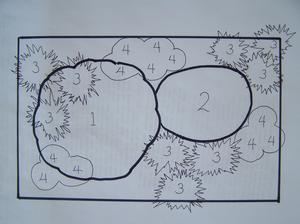Design Part IV: Art and Dangerous Minds
We have all been using at least some of these tools and principles of design every time we put trowel to earth. Certainly we consider the size and aesthetics of a plant in relation to its neighbors. For you as for me reading about these guides perchance clarified that which we have intuitively employed all along. But let’s consider a few ways to look at these tools and principles so that we might better understand how to employ them.
Think of the Tools of Design as functional elements – the dots if you will. The forms of the dots may be cascading, round, spreading and flat, pyramidal or fastigiated. The outline of the variously formed dots is line. These dots may be large or small, with light texture or heavy. The dots may also be differently colored within the outline in any texture or shape (form). The dots are representative of the physical characteristics of the plants; they are the Tools. The ways in which you connect these dots is application of the Principles of Design. You can arrange these dots in any configuration. That is your personal choice; your creative self at work and play. In a larger context you can organize your plant choices, your tools, into your garden applying the Principles of Design to sections or garden rooms that with sequence (theme) will connect your landscape into an artful whole.
PAINT YOUR LANDSCAPE
Another analogy from which to look upon these tools and principles is to think of your landscape as a canvas with each plant a brushstroke. The brushstrokes are the Tools of Design. Larger brushstrokes would be larger elements as smaller dabs of paint will represent smaller. Groups of smaller dabs would be groups of smaller elements and so forth. Thick, multi-angled dabs of paint would represent bolder textures while a shallow brushstroke, flat to the canvas, would approximate lighter texture. The palette of color can be broad or limited. Application of the Principles of Design would be the arrangement of the collection of brushstrokes and how they relate to each other. The ways in which you connect and contrast the brushstrokes and choose the sizes, shapes and colors will determine your personal style, your artistic handprint upon the canvas. Those of you with artistic ability might try to actually draw or paint the landscape that is in your mind’s eye in an impressionist or even pointilistic style. For the rest of us (I can’t draw to save my life!) just getting outside and studying the area where we wish to make a new garden or rehabilitate an existing one, and then jotting down ideas might have to suffice. But there is now computer software geared to landscape gardeners, landscape architects and the home gardener. These programs may also be helpful.
CONNECT THE DOTS
It may be easier for you to think of one string of dots, brushstrokes or plant choices at a time. Connect the dots. Once you have one string down on paper or canvas then you might add a second contrasting contrapuntal string in back of the first. If the area you are landscaping is large enough then add a third contrapuntal line and so on. Of course, you must be aware of the adult sizes of the plant material. The shorter plants will be in the front row, the tallest in the rear. However, your rows should be fluid, for instance, if you have a medium tall wide-spreader that cascades placed in the middle row, eliminate a few small plants in the front row where it may pour forth. Or you may decide you need a tall, narrow exclamation point in the middle row with a shorter shrub used in repetition as foil and balance in the third row behind the accent. Liquidity will blur any strict lines, soften and ultimately add depth and mix it up into a more satisfying combination. In any case, we may not get it right the first time. Sometimes, once the garden is planted, it takes a while to know if any changes need to be enacted. You will likely have to live with the garden before you know. However, forethought with careful research and planning will enable us to keep any changes that might have to be made down to a minimum. The more you employ these principles the better you will become at it with fewer aesthetic mistakes. But if you have to make changes your shovel is your best friend!
You can become a better designer by incorporating the Tools and Principles of Design. You can improve the aesthetics of your garden. You can grow as a gardener as your plants grow into the vision you have enacted. The possibilities are as exciting as they are mind-boggling! Go forth, dig in and make art.
Penned by Wayne Paquette, Winter 2008
